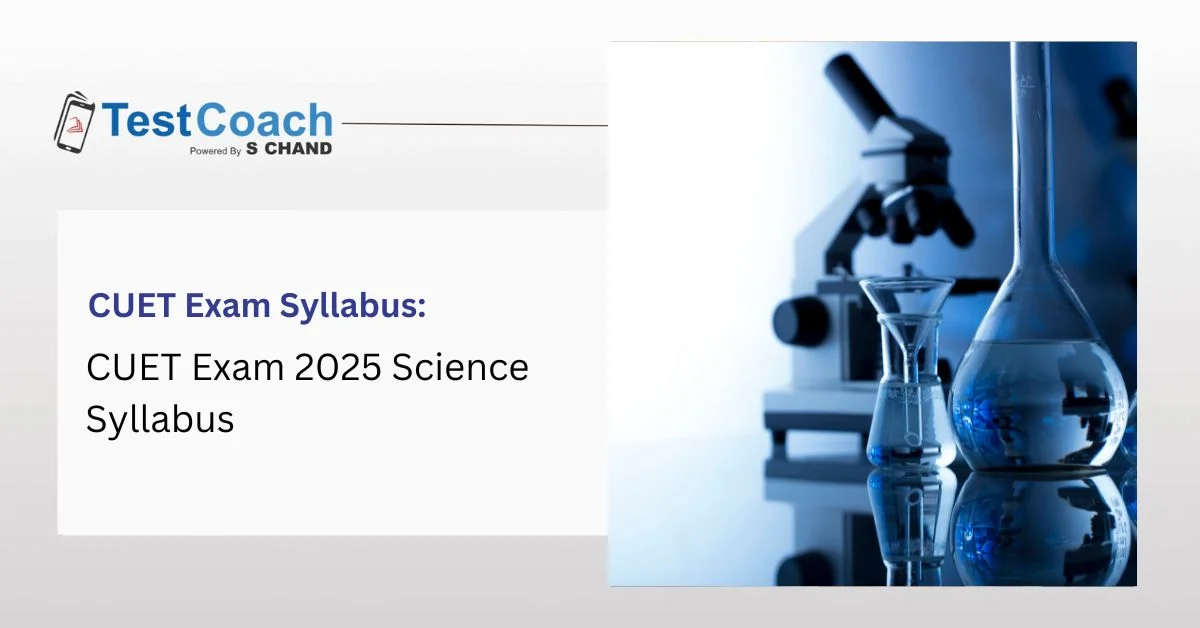The Common University Entrance Test (CUET) is a pivotal examination for students aspiring to get into some of India’s top universities. For science students, CUET is particularly significant as it covers a wide range of subjects that are critical for further education in fields like engineering, medical sciences, and research. In this guide, we will walk you through the CUET syllabus for science students, including a detailed subject-wise breakdown and the exam pattern, so you can be fully prepared.
CUET 2025 Exam Pattern
The CUET 2025 exam follows a structured pattern to evaluate the student’s knowledge across multiple subjects. Here’s a breakdown of what to expect:
- Structure of the Exam: The exam is divided into subject-specific sections.
- Subjects Covered: Physics, Chemistry, Biology, Mathematics, and additional sections like Logical Reasoning and General Knowledge.
- Number of Questions and Marks Distribution: Each section consists of multiple-choice questions (MCQs) with a specific mark’s distribution.
- Duration of the Exam: The exam lasts for about 2-3 hours, depending on the sections chosen.
Core Science Subjects in CUET 2025
For science students, the core subjects include Physics, Chemistry, Biology, and Mathematics. Each of these subjects is crucial, and a strong foundation will be the key to excelling in CUET. In CUET 2025, core science subjects fall under the Science Domain-Specific Subjects as per the CUET UG syllabus. The key subjects are:
| Subject | Major Topics |
|---|---|
| Physics | Mechanics, Thermodynamics, Electromagnetism, Optics, Modern Physics |
| Chemistry | Physical Chemistry (Atomic Structure, Chemical Bonding), Organic Chemistry (Hydrocarbons, Biomolecules), Inorganic Chemistry (Periodic Table, Coordination Compounds) |
| Mathematics | Algebra (Matrices, Determinants), Calculus (Limits, Differentiation, Integration), Probability & Statistics |
| Biology | Cell Biology & Genetics, Human Physiology, Ecology & Evolution |
| Computer Science | Programming (Python, C++), Database Management (SQL), Networking & Cybersecurity |
| Environmental Science | Ecosystem & Biodiversity, Climate Change & Pollution, Sustainable Development |

Physics Syllabus for CUET 2025
Physics is one of the core subjects in the Common University Entrance Test (CUET) 2025, designed for students aspiring to pursue science and engineering courses at central universities. The syllabus primarily follows the NCERT Class 11 and Class 12 curriculum, covering key topics such as Mechanics, Thermodynamics, Electromagnetism, Optics, and Modern Physics. The exam will assess conceptual understanding, problem-solving abilities, and application-based knowledge through multiple-choice questions (MCQs). A well-structured preparation strategy focusing on theoretical concepts, numerical problem-solving, and mock tests will help students excel in CUET Physics.
| Unit | Topics Covered |
|---|---|
| Unit 1: Mechanics | Motion in a Straight Line, Motion in a Plane, Laws of Motion, Work, Energy & Power, Rotational Motion, Gravitation |
| Unit 2: Thermodynamics | Thermal Properties of Matter, Thermodynamic Processes, Laws of Thermodynamics, Kinetic Theory of Gases |
| Unit 3: Oscillations & Waves | Simple Harmonic Motion, Damped & Forced Oscillations, Wave Motion, Sound Waves |
| Unit 4: Electricity & Magnetism | Electric Charges & Fields, Electrostatic Potential & Capacitance, Current Electricity, Moving Charges & Magnetism, Electromagnetic Induction, Alternating Current |
| Unit 5: Optics & Waves | Reflection & Refraction of Light, Lenses & Optical Instruments, Wave Optics (Interference, Diffraction, Polarization) |
| Unit 6: Modern Physics | Dual Nature of Matter, Photoelectric Effect, Atomic Models, Nuclear Physics (Radioactivity, Nuclear Reactions) |
| Unit 7: Electronic Devices | Semiconductors, Diodes, Transistors, Logic Gates & Digital Circuits |
| Unit 8: Communication Systems | Basics of Communication, Modulation, Electromagnetic Waves |
Exam Pattern for CUET Physics (Expected)
- Type: Multiple Choice Questions (MCQs)
- Mode: Computer-Based Test (CBT)
- Duration: 45–60 minutes
- Total Questions: 50 (Answer 40)
- Marking Scheme: +5 for correct answer, -1 for incorrect answer
Chemistry Syllabus for CUET 2025
Chemistry is a crucial subject in the Common University Entrance Test (CUET) 2025, essential for students aspiring for BSc, BTech, and other science-related programs. The syllabus follows the NCERT Class 11 and Class 12 curriculum, covering Physical, Organic, and Inorganic Chemistry. The exam will test conceptual clarity, numerical problem-solving skills, and application-based understanding through multiple-choice questions (MCQs). A strategic approach focusing on theory, equations, and reaction mechanisms will help students perform well in the CUET Chemistry section.
CUET 2025 Chemistry Syllabus (Unit-wise Breakdown)
| Unit | Topics Covered |
|---|---|
| Physical Chemistry | Some Basic Concepts of Chemistry, States of Matter, Atomic Structure, Chemical Bonding & Molecular Structure, Chemical & Ionic Equilibrium, Thermodynamics, Redox Reactions, Solutions, Electrochemistry, Surface Chemistry, Chemical Kinetics |
| Organic Chemistry | General Organic Chemistry, Hydrocarbons (Alkanes, Alkenes, Alkynes), Haloalkanes & Haloarenes, Alcohols, Phenols & Ethers, Aldehydes & Ketones, Carboxylic Acids, Organic Nitrogen Compounds (Amines), Biomolecules (Carbohydrates, Proteins, Nucleic Acids), Polymers, Chemistry in Everyday Life |
| Inorganic Chemistry | Periodic Table & Periodicity, Chemical Bonding & Molecular Structure, Hydrogen & Its Compounds, The s-Block & p-Block Elements, d-Block & f-Block Elements, Coordination Compounds, Environmental Chemistry |
Biology Syllabus for CUET 2025
Biology in CUET 2025 covers NCERT Class 11 & 12 topics like Cell Biology, Human Physiology, Genetics, and Ecology. The exam features MCQs, testing conceptual and application-based knowledge.
CUET 2025 Biology Syllabus (Unit-wise Breakdown)
| Unit | Topics Covered |
|---|---|
| Diversity of Life | Biological Classification, Kingdoms (Monera, Protista, Fungi, Plantae, Animalia), Viruses & Viroids |
| Structural Organization in Animals & Plants | Morphology & Anatomy of Flowering Plants, Animal Tissue Types |
| Cell Biology & Biomolecules | Cell Structure & Function, Cell Organelles, Biomolecules (Proteins, Carbohydrates, Lipids, Nucleic Acids), Cell Division (Mitosis & Meiosis) |
| Plant Physiology | Transport in Plants, Photosynthesis, Respiration, Growth & Development, Plant Hormones |
| Human Physiology | Digestion, Respiration, Circulation, Excretion, Nervous System, Endocrine System, Reproductive System |
| Reproduction & Genetics | Sexual & Asexual Reproduction, Mendelian Genetics, DNA Replication, RNA & Protein Synthesis, Genetic Disorders |
| Evolution & Human Health | Theories of Evolution, Human Evolution, Immunity, Vaccination, Diseases (Bacterial, Viral, Fungal, Parasitic) |
| Biotechnology & Its Applications | Genetic Engineering, Recombinant DNA Technology, Applications in Medicine & Agriculture |
| Ecology & Environment | Ecosystem Structure & Function, Biodiversity & Conservation, Pollution & Climate Change, Sustainable Development |
Mathematics Syllabus for CUET 2025
Mathematics in CUET 2025 follows NCERT Class 11 & 12, covering key topics like Algebra, Calculus, Probability, and Coordinate Geometry. The exam consists of MCQs, testing problem-solving skills and conceptual clarity.
CUET 2025 Mathematics Syllabus (Unit-wise Breakdown)
| Unit | Topics Covered |
|---|---|
| Algebra | Matrices, Determinants, Complex Numbers, Quadratic Equations, Permutations & Combinations, Binomial Theorem |
| Calculus | Limits & Continuity, Differentiation, Applications of Derivatives, Integration, Definite & Indefinite Integrals, Differential Equations |
| Coordinate Geometry | Straight Lines, Circles, Parabola, Ellipse, Hyperbola, 3D Geometry (Planes & Lines) |
| Trigonometry | Trigonometric Functions, Identities, Heights & Distances, Inverse Trigonometric Functions |
| Probability & Statistics | Probability Theorems, Random Variables, Mean, Median, Variance, Standard Deviation |
| Vectors & Linear Programming | Vectors, Scalar & Vector Products, Linear Programming Problems (LPP) |
| Mathematical Reasoning | Statements, Logical Operations, Deductive & Inductive Reasoning |
Additional Sections in CUET 2025 for Science Students
Apart from core science subjects (Physics, Chemistry, Mathematics, and Biology), CUET 2025 includes other important sections:
| Section | Details |
|---|---|
| General Test (GT) | Covers General Knowledge, Current Affairs, Logical & Analytical Reasoning, Numerical Ability, and Quantitative Reasoning. Required for some universities. |
| English Language | Tests Reading Comprehension, Grammar, Vocabulary, Synonyms, Antonyms, and Sentence Rearrangement. |
| Domain-Specific Subjects | Additional subjects like Computer Science, Environmental Science, Engineering Graphics, Agriculture, and Biotechnology, depending on the course requirements. |
Importance of Solving Previous Year Papers
Solving previous year papers is one of the best ways to prepare. It helps in:
- Understanding Question Patterns: Knowing what types of questions are commonly asked.
- Self-Assessment: Tracking your progress and identifying weak areas.
Resources for CUET 2025 Preparation
There are numerous resources available:
- Books: NCERT textbooks and reference guides for each subject.
- Online Platforms: Websites offering CUET mock tests and video tutorials.
- Coaching vs. Self-Study: Decide based on your learning style.
How CUET 2025 Can Impact Science Career Paths
CUET 2025 plays a crucial role in shaping science careers by providing a single entrance gateway to top central universities. Here’s how it impacts science students:
- Competitive Edge for Government & Private Jobs – A science degree from reputed institutions enhances opportunities in public sector jobs, corporate roles, and entrepreneurship.
- Access to Prestigious Institutions – Qualifying CUET allows entry into renowned universities offering BSc, BTech, and integrated science programs.
- Diverse Course Options – Science students can explore fields like Biotechnology, Data Science, Environmental Science, and Artificial Intelligence beyond traditional paths.
- Standardized Selection Process – Ensures merit-based admissions, reducing dependency on 12th board marks.
- Strong Career Foundation – Degrees from top universities open doors to higher studies (MSc, PhD) and professional careers in research, healthcare, IT, and engineering.
Conclusion
Preparing for CUET 2025 requires dedication and smart study strategies. With a clear understanding of the syllabus and exam pattern, coupled with effective time management, you can excel in this competitive exam. Remember, practice is key to mastering both the subject matter and the exam format.


Start Your CUET 2026 & 12th Board Prep Now!